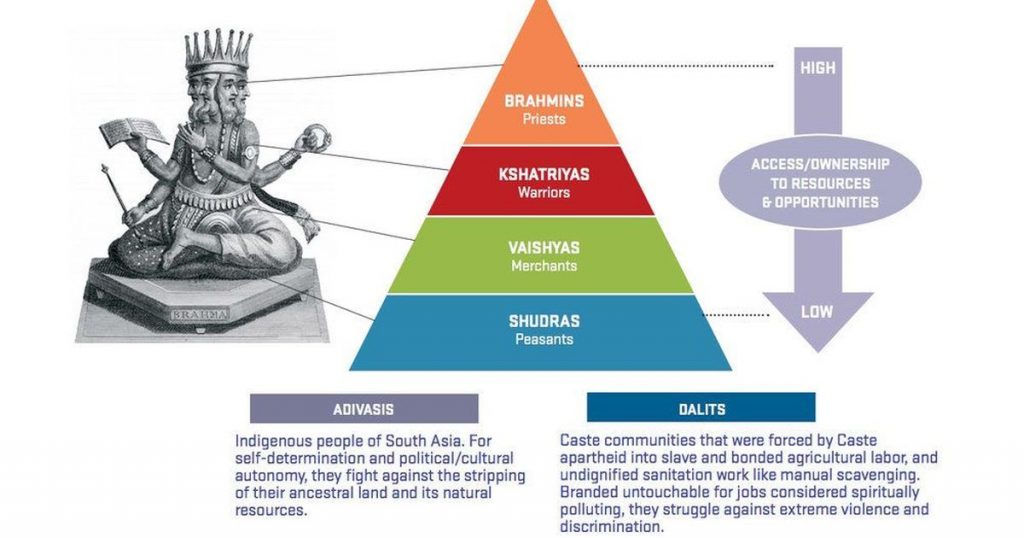Article written by Zsuzsa Tóth, volunteer based in Bangalore, India
Dear everyone!
Before I would share my personal stories, I would like to write about the caste-system in India, which still has a huge impact on people’s everyday lives. To understand their stories, their experiences, first we must take a look on this ancient tradition, which is the base of the social order in many Hindu people’s minds, just as in the reality.
The Hindu belief says that the people are classified into 4 castes, and these castes define what jobs they can do, what duties and what privileges they have. These four castes are the Brahmins (priests, teachers), Kshatriyas (rulers, warriors), Vaishyas (landowners, merchants) and Sudras (servants), and the 5th group is the group of the untouchables, called Dalits. One of the Hinduism’s holy books, the Srimad Bhagavatam has a part (7.11.35), which clearly says these castes must based on skills, qualities and activities. However in real life tradition, castes separate people according to their birth.

Since the Hindu traditions and the Indian culture is so intertwined, this kind of social order is not only a religious belief about the creation and classification of humankind, but a more thousands years old model of a real, functioning society.
The first big change in this social structure connected to the birth of India’s newest era. The Constitution of India came into force on 26th January, 1950, almost 3 years after that the country got its independence from the British colonizers. This definitely was the time of big changes and challenges. Many people, like the deeply respected Dr. B. R. Ambedkar were helping to ground this secular, democratic republic, and tried to put all the written words into action.
One part of the constitution addressed to help to improve inequalities derived from the caste (aka jati) system. For instance improve the situation of dalit (outcaste) people, who were untouchables, widely discriminated, overlooked and humiliated that time in the Hindu practice.
“The Indian Constitution has outlawed the practice of untouchability and the Indian Government has established special quotas in schools and parliament to aid the lowest jatis. Caste discrimination is not permitted in gaining employment and access to educational and other opportunities. But this does not mean that caste is illegal or has faded away.” (Jati: The Caste System in India | Asia Society)
In spite of the 73 years passed since, today India is still facing caste-based problems, discrimination and in rural areas, small villages untouchability is still in practice. In the previous weeks I read lots of articles with the following titles:
- A dalit man was killed for eating in front of upper-caste men
- Killed for sitting crossed-leg
- Threatened for riding a horse
- Three dalit boys were stripped and beaten for swimming
These are so shocking stories, that even the media picked it up. But I had to see, this is the tip of the iceberg. Many people meet daily discrimination, students are facing with constant bullying, later on they don’t get job, just because of their family roots. People live in fear, get threatened and humiliated because of their origin. This kind of discrimination is causing hard time in livelihood, providing the daily bread, or having a decent life without financial problems, which is the soil for even more cruel acts. The most vulnerable people sometimes try to survive with forcing their kids into illegal child-marriages, or selling their daughters as sex-slaves (devadasi). But dalits have to cope with mental pressure too. Not rare, that those youngsters, who are hardworking and lucky enough to make it to the university (dalits in higher education are only 14.4% out of total) are committing suicide because of the constant bullying and harassment by other students or even by professors.
I recommend you to watch this video about the experiences of Dalit people in India, produced by Vice.
Sources:
1) Mishra, A. (2019) Hinduism : Ritual, Reason and Beyond – A Journey Through the Evolution of 5000 Year Old Traditions. StoryMirror Infotech, Mumbai
2) “What is India’s caste system?” BBC News, June 19, 2019, https://www.bbc.com/news/world-asia-india-35650616
Zsuzsa is a Phiren Amenca volunteer in India, hosted by the Student Christian Movement of India, within the Erasmus+ KA2 Capacity building for Youth project “My Story of Resistance- from exclusion to active participation”.


